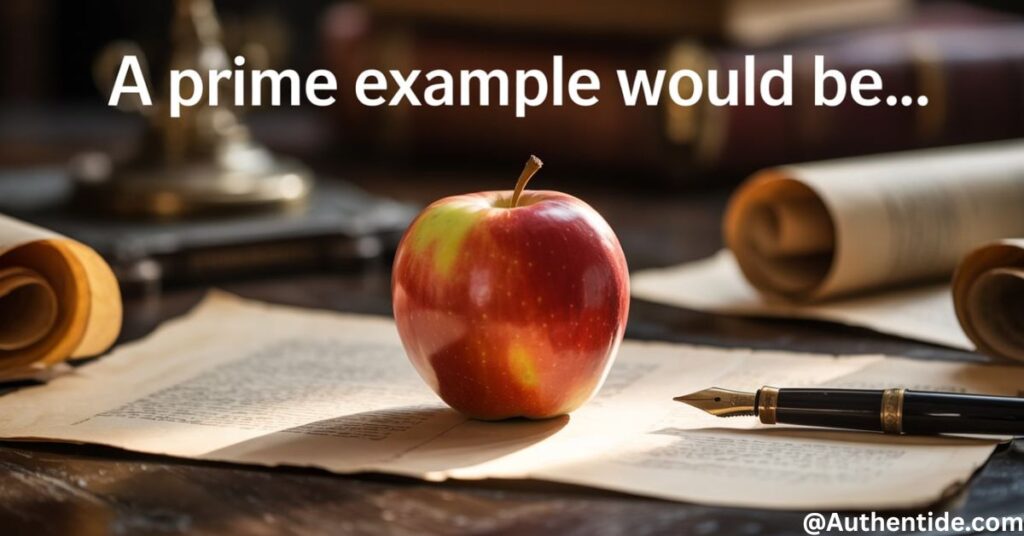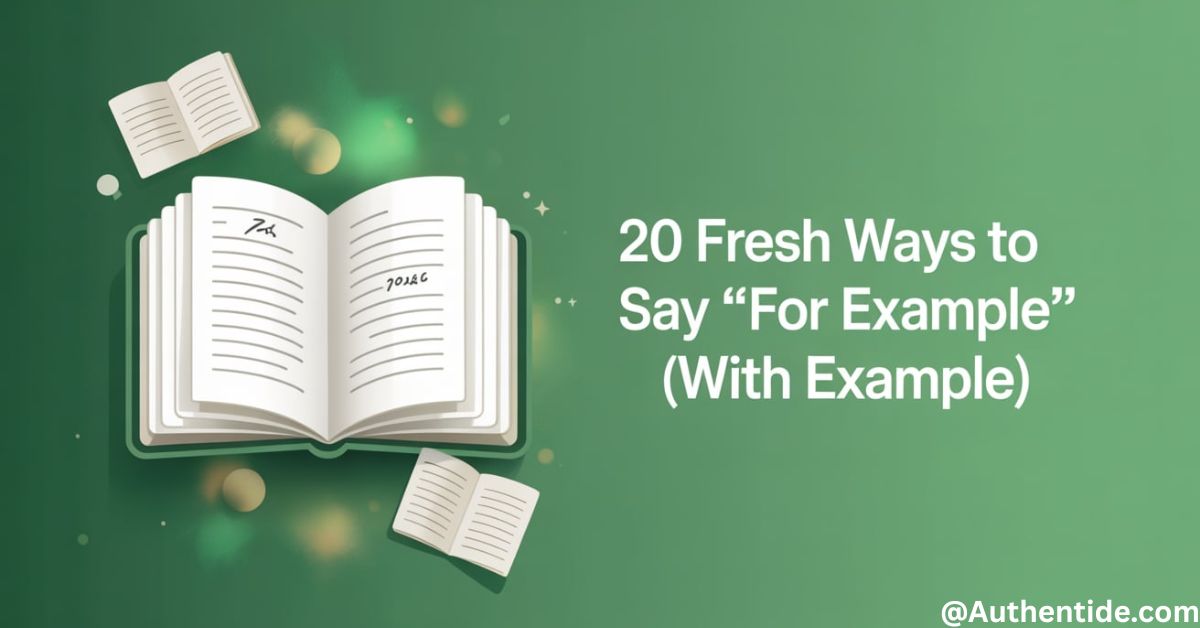For example alternatives breathe life into your writing, transforming mundane explanations into compelling illustrations that grab your reader’s attention. In a world where communication styles have evolved dramatically, relying on the same phrases repeatedly can make your message feel stale and uninspired. By expanding your vocabulary with fresh alternatives, you’ll instantly elevate your formal writing and create more engaging content that resonates with your audience.
Think about the last time you read something that truly captivated you chances are, the writer skillfully varied their language, avoiding repetitive phrases that drag down the reader’s experience. Whether you’re crafting a critical business communication, preparing for a sales call, or simply wanting to sound more articulate in informal situations, these alternatives will help you communicate more effectively and memorably.
Professional communicators know that language variety isn’t just about sounding sophisticated it is about maintaining your reader’s interest and ensuring your message sticks. In the following comprehensive guide, I’ll share twenty powerful alternatives to “for example” along with practical use cases that demonstrate exactly how to incorporate them seamlessly into your everyday communications.
What to Say Instead of “For Example”
- For instance…
- To give you an idea…
- As proof…
- Suppose that…
- To illustrate…
- Imagine…
- Pretend that…
- To show you what I mean…
- Let’s say…
- Case in point…
- e.g.
- Such as…
- In particular…
Why Varying Your Examples Matters in Communication
In today’s fast-paced business writing environment, capturing and maintaining attention has never been more challenging. When you use the same transitional phrases repeatedly, readers’ eyes glaze over, and your brilliant points get lost in the monotony. Corporate messaging that incorporates varied language demonstrates thoughtfulness and attention to detail qualities that set professional communicators apart.
Studies show that varied language increases comprehension and retention. By using different phrases to introduce examples, you create “pattern interrupts” that keep your audience mentally engaged. This technique is especially valuable in presentation writing, where maintaining audience interest is crucial to delivering your message effectively.
20 Powerful Alternatives to “For Example” (With Scenarios)
Here are 20 Powerful Alternatives to “For Example” (With Scenarios):
Professional and Formal Alternatives
1. “To illustrate…”

Perfect for formal writing contexts where you want to maintain a professional tone. This phrase suggests you’re about to provide a concrete demonstration of your point.
Scenario: In a detailed proposal document
“Our team consistently delivers projects ahead of schedule. To illustrate, the Johnson account was completed two weeks before the deadline, allowing the client to launch their campaign earlier than anticipated.”
2. “For instance…”
A classic alternative that works in almost any context, from casual conversations to polished communication.
Scenario: During a client meeting
“We’ve implemented this solution for several companies in your industry. For instance, when we worked with Meridian Technologies, they saw a 34% increase in conversion rates within the first quarter.”
3. “As an illustration…”
This phrase signals that you’re about to clarify a complex concept through a concrete example, making it ideal for educational or explanatory content.
Scenario: In a training manual
“Different customer segments respond to different messaging approaches. As an illustration, our senior demographic prefers detailed product descriptions focusing on reliability and value, while our younger users respond better to messages highlighting innovation and social impact.”
4. “Case in point…”
This confident phrase suggests that what follows is strong evidence that perfectly proves your assertion.
Scenario: During a business meeting
“Our new onboarding process significantly reduces employee confusion. Case in point, the April cohort reported 89% satisfaction compared to 62% with our previous system.”
5. “To put it in perspective…”
This phrase helps readers grasp abstract concepts by relating them to something more tangible or familiar.
Scenario: In a business writing context explaining technical concepts
“The new server infrastructure handles 10,000 requests per second. To put it in perspective, that’s like processing everyone in a sold-out Madison Square Garden entering simultaneously, with capacity to spare.”
Conversational and Engaging Alternatives
6. “Picture this…”

An engaging, visual way to introduce an example that works well in informal situations or when you want to create a mental image.
Scenario: In a marketing brainstorming session
“Our target customers are busy professionals who value convenience. Picture this: Sarah, a 42-year-old executive, is trying to order dinner for her family while finishing a presentation and helping her son with homework. Our app needs to solve her problem in under 30 seconds.”
7. “Let’s say…”
This invites your audience into a hypothetical scenario, making it perfect for sales calls when you want to personalize the conversation.
Scenario: During a sales pitch
“Our software adapts to your specific business needs. Let’s say you notice a surge in customer inquiries every Monday morning. Our system would automatically allocate more resources during those peak hours, ensuring no customer waits more than two minutes.”
8. “Imagine…”
This prompts your audience to visualize a scenario, creating emotional engagement with your example.
Scenario: In a product features presentation
“Our new platform simplifies your entire workflow. Imagine walking into work on Monday, opening just one application instead of seven, and having all your tasks prioritized automatically based on deadlines and team dependencies.”
9. “Consider this scenario…”
This phrase works well when you want to present a detailed real-world example that demonstrates your point.
Scenario: In a corporate messaging document about crisis management
“Our response protocol has been tested in various emergencies. Consider this scenario: When client Westbrook Industries experienced a data breach last year, our team had their systems secured within 45 minutes and a communication plan executed within the hour.”
10. “Take…”
A direct, concise way to introduce an example when brevity is important.
Scenario: In a quick team session
“We need to prioritize user experience in every feature decision. Take our login process—we reduced it from three steps to one, and saw a 27% increase in return users.”
Data-Driven and Evidence-Based Alternatives
1. “The data shows…”
Perfect for introducing examples backed by research or statistics in a business pitch or report.
Scenario: In a social strategy presentation
“Our approach to content targeting delivers measurable results. The data shows that our clients typically experience a 40% increase in engagement when implementing our personalized recommendation algorithm.”
12. “One study found…”

This phrase establishes credibility by grounding your example in research.
Scenario: In a persuasive business proposal
“Investing in employee development yields significant returns. One study found that companies with comprehensive training programs experienced 24% higher profit margins than those without such programs.”
13. “According to our research…”
This positions you as an authority while introducing supporting evidence.
Scenario: In a workplace communication about a new initiative
“The flex-time policy will benefit both employees and the company. According to our research, similar policies have resulted in a 31% decrease in turnover and a 22% increase in reported job satisfaction.”
14. “A recent analysis revealed…”
This phrase suggests you’re sharing up-to-date information, adding freshness and relevance to your example.
Scenario: In a client feedback session
“Your customers are increasingly using mobile devices to access your services. A recent analysis revealed that 73% of your website traffic now comes from smartphones, compared to 45% just one year ago.”
15. “As demonstrated by…”
This phrase works well when referring to a concrete case study or previous experience.
Scenario: During a sales outreach call
“Our marketing automation tools deliver measurable ROI. As demonstrated by our client Pinnacle Industries, who increased qualified leads by 68% in their first quarter using our platform.”
Creative and Unique Alternatives
16. “To bring this to life…”

This phrase signals that you’re about to make an abstract concept more tangible through an example.
Scenario: In a presentation writing context explaining a complex process
“Our new workflow optimizes cross-departmental collaboration. To bring this to life, consider how the Henderson project moved from concept to completion in just six weeks because our system automatically alerted each team exactly when their input was needed.”
17. “Here’s a snapshot…”
This phrase suggests you’re providing a glimpse or sample that represents a larger picture.
Scenario: In an email campaign about your service benefits
“Our platform gives you comprehensive analytics about your customer journey. Here’s a snapshot: You’ll see exactly which email subject lines drive the most opens, which product pages keep visitors engaged the longest, and which checkout modifications reduce abandonment rates.”
18. “If you were to look at…”
This hypothetical framing engages your audience by inviting them to consider a specific perspective.
Scenario: In a customer conversation about product benefits
“Our service saves significant administrative time. If you were to look at your current invoice processing workflow, you’d likely find at least three redundant approval steps that our system eliminates entirely.”
19. “Think of it this way…”
This phrase introduces a metaphor or analogy that helps clarify your point.
Scenario: In an office meeting explaining a new process
“Our new project management system might seem complex at first. Think of it this way: It’s like having a GPS for your entire workflow it shows you where you are, identifies the fastest route to completion, and alerts you to potential roadblocks before you hit them.”
20. “A prime example would be…”

This phrase suggests you’re about to share a particularly relevant or perfect illustration of your point.
Scenario: In a customer testimonial collection email
“We’d love to hear how our service has improved your operations. A prime example would be any time-saving benefits you’ve experienced, or processes that now run more smoothly since implementation.”
How to Choose the Right Alternative for Your Context
Selecting the most effective alternative to “for example” depends largely on your audience and communication medium. In formal writing situations like academic papers or legal documents, options like “to illustrate,” “for instance,” or “e.g.” maintain the appropriate professional tone.
For business communication with clients or upper management, phrases like “case in point” or “to demonstrate” show polish and precision. In internal communication with your team, more conversational options like “picture this” or “let’s say” create engagement and build rapport.
When crafting email outreach or cold emails, being concise is crucial. Opt for shorter alternatives like “such as” or “e.g.” to keep your message tight. For sales calls or in-person presentations, more dynamic phrases like “imagine” or “consider this scenario” help create vivid mental images that make your points memorable.
Specific Applications for Different Communication Needs
In Email Communication
When writing emails, clarity and concision usually take priority. Phrases like “for instance” and “such as” work well because they’re familiar without being repetitive. For prospecting emails, using “to show you what I mean” followed by a relevant example can effectively demonstrate your understanding of the prospect’s needs.
Scenario Example:
Subject: Solution to Your Inventory Challenges
Hi Rebecca,
I noticed your recent LinkedIn post about inventory management difficulties. Our platform specializes in solving these exact issues for retail businesses. To show you what I mean, one of our clients, Village Boutique (similar in size to your operation), reduced their inventory costs by 23% in just two months using our predictive ordering feature.
Would you be open to a quick 15-minute call this week to discuss how we might achieve similar results for your business?
Best regards,
Michael
In Presentations and Public Speaking
For visual aid design and presentations, more engaging phrases create stronger audience connections. Options like “picture this” or “imagine” are particularly effective because they prompt your audience to create mental images, enhancing retention of your message.
Scenario Example:
During a product launch presentation:
“Our new app simplifies expense reporting dramatically. Imagine stepping off a plane after a business trip, snapping photos of your receipts while waiting for your luggage, and having a complete expense report categorized and submitted before you reach your taxi. That’s the convenience we’ve built.”
In Sales Materials
When describing product specifications or benefits in sales materials, clarity and specificity are key. Phrases like “as an illustration” or “a practical example” help potential customers understand exactly how your offering applies to their situation.
Scenario Example:
From a product brochure:
“Our CRM integrates seamlessly with your existing tools. As an illustration, when a customer contacts your support team, their complete purchase history, previous support interactions, and social media engagement all appear in a single dashboard, enabling your team to provide informed, personalized assistance instantly.”
Social Media Applications
In the realm of social media plan development, concise, engaging language is essential. When explaining brand presence strategies or content approaches, alternatives like “take” or “here’s a snapshot” keep explanations brief yet informative.
Scenario Example:
In a LinkedIn post about digital outreach:
“Consistent visual branding drives recognition across platforms. Take our client Sunrise Organics—by maintaining consistent color palettes and graphic elements across Instagram, Facebook, and their email newsletters, they increased brand recall by 34% in just three months.”
The Impact of Example Selection on Message Effectiveness
Regardless of which alternative phrase you choose, the examples themselves must be relevant, specific, and impactful. The most elegant transition phrase can’t salvage an irrelevant example.
When selecting examples for business writing, ensure they:
- Directly support your main point
- Contain specific details rather than generalizations
- Relate to your audience’s experience or interests
- Include quantifiable results when possible
This approach transforms your examples from mere illustrations into powerful persuasive tools that drive your message home.
When to Stick with “For Example”
Despite all these alternatives, sometimes “for example” remains the best choice. Its familiarity can be an advantage when:
- You’ve already used several alternatives and need variety
- You’re writing for an international audience who may be more familiar with this standard phrase
- You’re explaining something particularly complex and don’t want to add cognitive load with unfamiliar transitions
- The rhythm of your sentence flows better with this two-word phrase
Remember: Communication effectiveness trumps variety. Choose the phrase that serves your message best, even if it’s the classic standby.
Frequently Asked Question
What is another word for example in an essay?
When writing essays, “illustration” works beautifully as an alternative to “example.” It carries academic weight while suggesting your point is being visually demonstrated rather than merely exemplified.
Other solid options include: instance, case, demonstration, representation, specimen, and exemplification.
How can you say for example in an essay?
- For instance
- To illustrate
- As a case in point
- Such as
- Namely
- Specifically
- In particular
- To demonstrate
- Consider the case of
- By way of illustration
- As evidenced by
- e.g. (in parenthetical references)
What phrase can replace “for example”?
- “For instance” works perfectly when you need a direct substitute without changing tone.
- “To illustrate” adds a visual dimension to your explanation.
- “Case in point” delivers more emphasis when highlighting strong evidence.
- “Such as” flows naturally when introducing multiple examples.
- “Let’s say” creates a conversational, hypothetical scenario.
- “Specifically” focuses attention on a particularly relevant example.
- “Consider” invites your audience to examine a scenario more deeply.
- “Namely” works well when listing specific items after a general statement.
- Choose the replacement that best matches your tone and context!
What is a synonym for eg?
Other alternatives include:
- Such as
- For instance
- Namely
- To illustrate
- Including
- Like
- Specifically
Conclusion
Expanding your repertoire beyond the basic “for example” demonstrates attention to detail and linguistic sophistication in your workplace communication. By thoughtfully selecting from these twenty alternatives based on your context, audience, and purpose, you’ll create more engaging, persuasive, and professional communications.
Whether you’re crafting a sales pitch, preparing for a client meeting, developing email marketing materials, or enhancing your business writing, these fresh alternatives will serve you well. They’ll help you maintain reader interest, emphasize important points, and ultimately communicate more effectively.

Your go-to place for smart synonyms and celebrity updates. Muhammad Hassan Abid is dedicated to creating useful, engaging content that informs, inspires, and truly serves your curiosity

